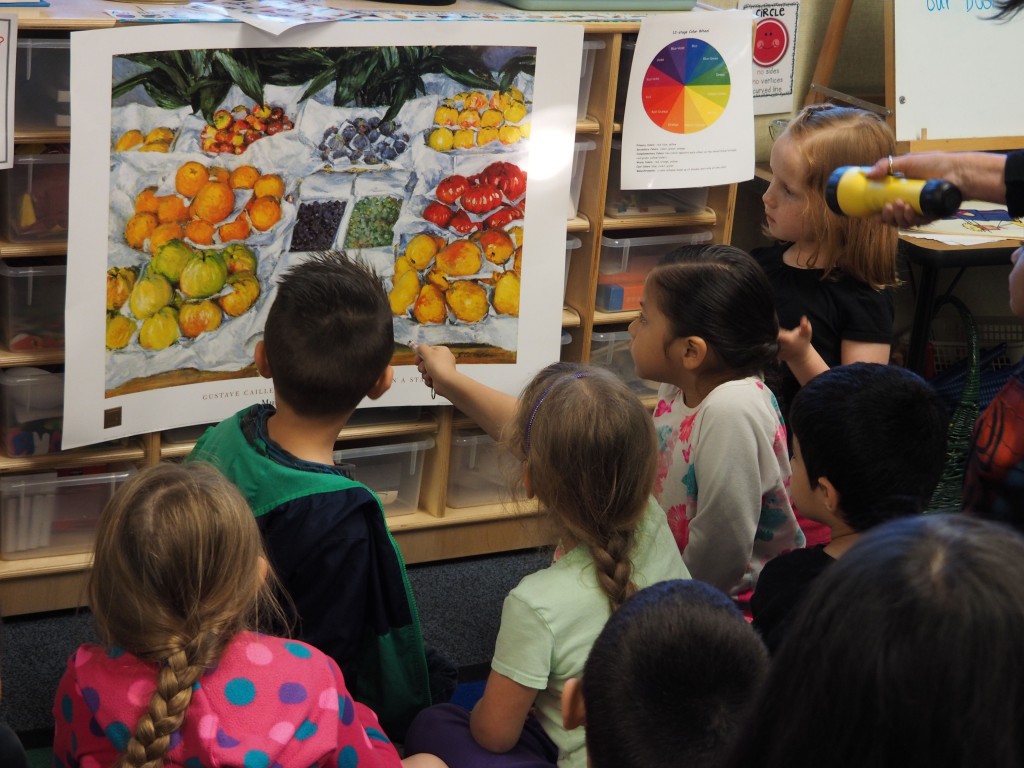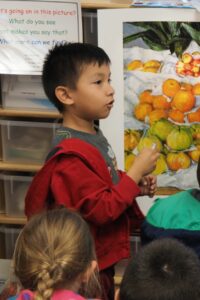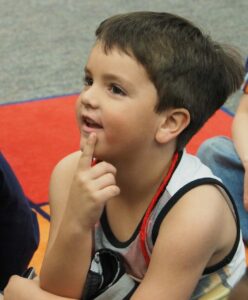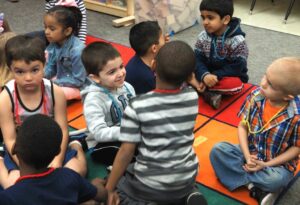When Talking With Children About Art Teachers Should Use Terms Such as
 Liv Ames for EdSource
Liv Ames for EdSource
Transitional kindergarten students talk over 19th century French artist Gustave Caillebotte's painting "Fruit Displayed on a Stand" at Figarden Simple Schoolhouse in Fresno.
Fine art lessons for pre-kindergarten students are moving beyond finger paints and into the worlds of van Gogh, da Vinci and Rivera.
Teachers in a number of districts in California are using classic works of fine art to inspire some of the youngest students to notice closely, retrieve critically and discuss respectfully – all key elements of the Common Core approach to learning.
Past looking closely together as a course at a Picasso or a Cezanne, four- and 5-year-olds are learning how to find and translate their thoughts into linguistic communication and listen and respond to multiple perspectives.
This arroyo for 1000-12 students was adult about xx years ago by the co-founders of Visual Thinking Strategies, a nonprofit based in New York that provides preparation in the method to schools and fine art museums. More than recently, the nonprofit has introduced the concept to pre-1000 classes.

Liv Ames for EdSource
Alexander Chitay, a transitional kindergartner, uses a light amplification by stimulated emission of radiation light to point out what he wants to hash out about the painting.
It appears to be growing in its appeal since the introduction of the Common Cadre standards adopted by California and 42 other states. During the past 2 years, the nonprofit'south national trainings of educators take doubled, said Amy Chase Gulden, national program director. The nonprofit has trained teachers in more than than 70 schools in the Bay Surface area, Northern California and Los Angeles.
Research studies on the method have shown that students in classes where the visual thinking programme was used had a better understanding of visual images, exhibited stronger growth in math and reading, and showed better social-emotional growth than students in classes that did not use the programme. The approach was especially effective for English learners.
The visual thinking method asks 3 questions of young students: What's going on in this picture? What practice you see that makes you say that? What more than can we observe?
This approach teaches students how to take the time to observe closely, depict what they run into in detail and provide evidence for their observations, Gulden said, "the kinds of skills that the Common Core asks for."
Such programs are function of a new movement in English language arts to develop visual literacy, said Kim Morin, a professor who teaches integrated art at Fresno State University.
"It kind of came in with the Mutual Core – a more than holistic approach," Morin said. "As society becomes more digital, information technology's non plenty to simply be able to read words; nosotros accept to exist able to read images."
"We have to exist able to look at an image and sympathise it, not just react to it," she said.
Some districts, such as San Francisco Unified, were applying this method long before Mutual Core standards were adopted. When Elizabeth Levett, who teaches kindergarten at George Peabody Elementary in San Francisco, introduced the Visual Thinking Strategies plan into her classroom about eight years ago, she said she saw the growth in her students' language "right away from ane lesson to the side by side."
"They'll start the year with 'I see a ball,'" she said. "Afterward that it snowballs. It's astonishing."
"We're giving them linguistic communication they wouldn't usually take in a context that is meaningful to them right in the moment," said Elizabeth Levett, a kindergarten teacher at George Peabody Elementary in San Francisco.
Teachers answer to a student'due south comment on a painting by paraphrasing the annotate and taking it to the side by side level, Levett said. Perhaps a student will detect a figure. The teacher will so say, "so you are noticing this figure in the left-manus foreground of the painting?"
"We're giving them language they wouldn't normally have in a context that is meaningful to them right in the moment," she said.

Liv Ames for EdSource
Donavon Quezada, iv, is looking closely at a painting in his transitional kindergarten class in Fresno.
It is important for the teacher to paraphrase the student's comment in such a way that the student feels understood and the residuum of the group can grasp what the student has said, Gulden said. Teachers have to permit become of their agendas and ideas and follow the kid, she said, some other Common Core approach to learning.
Sometimes the pupil may exist searching for a word and the teacher can restate the pupil'due south idea using the word, she said.
The approach "builds vocabulary and fluency," Gulden said. The method is particularly effective with contempo immigrants, she said.
School psychologist Julie Montali also finds the method works well with English language learners. Montali has an art degree and has been trained in the visual thinking method. She developed a similar curriculum for pre-K students at Fresno Unified with English language arts instructional coach Claudia Readwright.
"Kids act as linguistic communication models for other kids," Montali said. "Oftentimes another kid is the best instructor."
The open up-ended arroyo to discussing the painting also equalizes the experience, she said. The art is new for everyone, sometimes including the teacher. The word of the ideas inspired past the art does non require prior knowledge, and there are no wrong answers. That makes information technology easier for shy students or those learning English to participate, she said.
Children too reply to the ideas of other students and larn to look at things from another person's perspective, Montali said. They continue the discussion moving with minimal intervention from the teacher, the kind of self-directed learning emphasized by the Common Core.
In the procedure of discussing the paintings, the children learn how to take different opinions without rancor, Levett said. They use terms such every bit "I'm noticing" or "I want to build on what he said."
Juliet James, who has been using the method to teach 2nd-graders at Old Adobe Elementary School in Petaluma for the past five years, said students are polite. "They'll say, 'I disagree with Karen because of this reason.' They take to give the bear witness," she said.
Using high-quality artwork is also of import, Morin said, peculiarly in terms of stimulating observations by the children.
"Y'all tin keep going back to a masterwork and see something different every fourth dimension," she said. "If it's not a high-quality work, it doesn't take that depth."

Liv Ames for EdSource
Students in a transitional kindergarten class in Fresno talk among themselves most the piece of work of art they just discussed as a class.
On a recent mean solar day, the transitional kindergarten students in Yvonne Stout-Barrett's class at Figarden Elementary School in Fresno eagerly gathered around a print called "Fruit Displayed on a Stand up" by the 19th century French creative person Gustave Caillebotte. They began talking nearly what they saw, including shapes and colors. Building vocabulary by discussing shades such every bit magenta, carmine or chartreuse is one way talking about fine art builds more sophisticated language.
Teachers say they see the effect of the method in other subject areas.
Brian Harrigan, who teaches preschool students at San Francisco Unified, said that since he has used the visual thinking method, he notices the departure when he is reading a story to the children.
"They showtime describing things in the film more fully," he said.
Such close observations of art aid children learn to visualize, which helps them when they begin to read, Morin said. "If you can visualize what you are reading, you are a stronger reader rather than only reading word-to-word," she said.
The same methods of showing prove for what you are thinking or saying can piece of work with deconstructing a story or a mathematical graph, Gulden said.
James uses the method in didactics all subjects to her 2nd-graders, such every bit when she introduces the 100s number nautical chart to discuss place value.
"They volition talk about information technology being a grid, how each space is equal," she said. "They will observe the numbers going across are ane to 10. I and so come in and say that the horizontal numbers are i to ten. Then they will find the vertical numbers are counting by 10s."
"Very often young children accept an almost deeper perception of what they're seeing," said Fresno State professor Kim Morin. "They don't have preconceptions. They don't remember: 'I don't go information technology.'"
Fresno has decided to implement the curriculum by adding it to a class each yr, beginning with preschool children last twelvemonth and transitional kindergartners this year. The integrated approach volition follow the children equally they move through the One thousand-12 system.
Starting young has its advantages, Morin said. "Very frequently young children take an nigh deeper perception of what they're seeing," she said. "They don't have preconceptions. They don't think: 'I don't get it.'"
In a enquiry paper on talking about fine art with young people, David Bell, an acquaintance professor at the University of Otago in New Zealand, says that "children are less inhibited than many adults in their engagement with artworks."
"They may be surprised, entertained, puzzled or challenged past what they see," he said. "They are too likely to express their various responses to the works in exclamations, comments or conversations."
Teachers laud the method for slowing things down in a fast-paced world and building on immature children's natural ability to learn through observing.
"Everyone is worried about kids having access to engineering science," Levett said. "They're likewise piddling. They need to learn how to expect slowly, really observe. Everything in engineering science is click, click, click. This method hones the craft of looking deeply and really listening to each other."
To go more reports like this one, click here to sign upwards for EdSource's no-cost daily email on latest developments in education.
Source: https://edsource.org/2015/art-appreciation-helps-young-children-learn-to-think-and-express-ideas/77734
0 Response to "When Talking With Children About Art Teachers Should Use Terms Such as"
Post a Comment